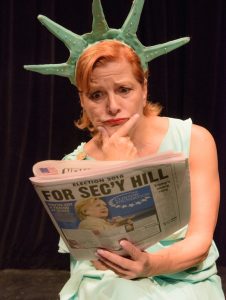

Embracing the patriotic spirit surrounding the upcoming election, Urban Stages’ Lady Liberty Festival delivers a witty look at the issue of immigration in modern America.
The program opens with Monica Bauer's Lady Liberty’s Worst Day Ever, in which Frances McGarry and J. Dolan Byrnes enact a meeting between Lady Liberty and her agent, who warns her that Trump’s planning to rebrand her image if she’s elected. Frances McGarry also stars in Bauer’s next piece, No Irish Need Apply, directed by Cheryl King, as she interviews a Muslim immigrant (Ali Andre Ali) who has applied to be a cashier in her souvenir shop. The writing is a little on-the-nose, as the quick scenes scratch the surface of the issues, but are too short to start a more profound conversation, which leaves the performances somewhat flat. Despite this, they provide a charming and humorous introduction to the evening.
The festival’s concluding piece, Dirty Paki Lingerie, looks at a myriad of Muslim women, who, after immigrating to New York, struggle to find love. Playwright and star Aizzah Fatima creatively weaves these women’s stories, which range from a young woman considering a loveless marriage because of a soon-to-be-expired visa to a desperate mother scanning the matrimonial section of the paper to find her daughter a husband. Bound by common experiences of sexism and racism, Fatima’s characters examine how a woman displaced from her native culture can forge her own identity in a new city.
Directed by Erica Gould, Fatima plays each character with precision and skill, adopting different accents and mannerisms to differentiate the women while maintaining the common thematic thread that links them. Fatima’s writing circles back to characters irregularly and inconsistently, which at times made it difficult to discern whether we are meeting someone new, or catching up with a previous character. However, her stylistic range gives each performance a great deal of insight into the character, even those she only visits briefly.
To clarify the different characters, at times confused by the writing, the production design incorporates well-placed props and sound effects, such as the bustle of a restaurant or airport, to establish each new scene, which compensates for the minimalistic set. Though also simplistic, the costume choices work well, as Fatima wears a green scarf differently, as a hijab or simply wrapped around her neck, for each character. In addition to providing easier differentiation between characters, Fatima’s scarf visually represents the different ways the women relate to their native culture.
The festival creates a broad and incisive look at the issue of Muslim immigration in America. Bauer’s examination of Americans welcoming immigrants combined with Fatima’s portrayal of Muslim women in New York gives a dual perspective that affords the festival great insight. Fatima’s final questions to the audience certainly linger after the lights have gone out.